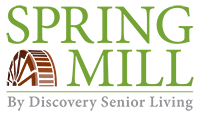Millions of Americans are living with osteoporosis, including many older adults, according to the Bone Health & Osteoporosis Foundation. This condition weakens bones and increases the risk of fractures, which can affect independence and quality of life. At Spring Mill, our senior living community in Phoenixville, PA, we often hear the same important question: can osteoporosis be reversed?
While the disease is common, the good news is that steps can be taken to slow its progress and improve senior bone health.
In this blog post, we’ll explain what osteoporosis is, osteoporosis treatment options, and how lifestyle changes can make a difference. We’ll also share how communities like Spring Mill support residents in staying active, safe, and well-nourished. Let’s get started.
What Is Osteoporosis?
Osteoporosis is a condition that causes bones to become brittle and weak.
Over time, the body may lose too much bone or make too little of it. This leads to lower bone density, which means bones can break more easily. Many people don’t know they have osteoporosis until a minor fall or bump causes a fracture.
The condition is especially common in older adults, and women are more likely to develop it, especially after menopause. Hormonal changes, age, and a family history of osteoporosis all increase the risk.
However, lifestyle habits also play a role. Not getting enough calcium or vitamin D, not staying active, smoking, and drinking too much alcohol can all contribute to bone loss.
With osteoporosis, there are usually no clear symptoms early on. That’s why bone density screenings are important as people age. Catching it early gives you a better chance to slow its effects and protect your bone health for the future.
Can Osteoporosis Be Reversed?
The short answer here is that while it can’t be fully reversed, it can be managed. With the right treatment and lifestyle changes, it’s possible to slow down bone loss, prevent fractures, and in some cases, even improve bone density slightly.
There are medications that help stop further bone breakdown. Some also support the rebuilding of bone over time.
These treatments don’t cure osteoporosis, but they do make the bones stronger and lower the risk of injury. That’s why early diagnosis is so important. The sooner treatment begins, the better the outcome.
In addition to medication, staying active, eating a healthy diet, and avoiding smoking and heavy alcohol use all play a role in managing the disease. Together, these steps support senior bone health and help prevent the condition from getting worse.
At Spring Mill, we believe in giving residents the tools they need to live well with conditions like osteoporosis through guidance, activity programs, and daily wellness support.
What Helps Improve Bone Health
Even though osteoporosis can’t be fully reversed, there are several ways to strengthen bones and protect against fractures. Improving your daily habits can make a real difference in your bone health over time.
A healthy diet is one of the essential steps, and calcium and vitamin D are key to maintaining strong bones. Older adults should aim to get enough calcium through foods like:
- Milk
- Yogurt
- Cheese
- Leafy greens
- Fortified cereals
Vitamin D helps the body absorb calcium and can be found in fatty fish, egg yolks, and fortified products. Many seniors also benefit from supplements if their doctor recommends them.
Regular exercise is also key. Weight-bearing activities like walking, light resistance training, and even simple stretches help keep bones and muscles strong. Balance exercises, such as tai chi or standing leg lifts, can help prevent falls, one of the biggest risks for people with osteoporosis.
As noted above, medications are available and often prescribed to slow bone loss and reduce the risk of fractures. These medications don’t rebuild bones completely but can help maintain or slightly improve bone density over time.
Finally, daily habits matter too. As noted above, avoiding smoking and limiting alcohol can help protect bone strength. Getting enough sleep and staying consistent with exercise and nutrition routines also support long-term health.
How Spring Mill Supports Bone Health
At Spring Mill, we create an environment that supports healthy bones for our residents. We design our daily routines to include activities that encourage movement and strength.
Regular group exercises, such as light walking and balance classes, help residents stay active and reduce the risk of falls. These activities also play a crucial role in maintaining senior bone health.
Our dining services focus on nutrition, ensuring that meals are rich in calcium and vitamin D. We work with nutritionists to plan menus that support healthy bones.
In addition, our caring staff helps residents keep track of their medications and medical appointments. This daily support is part of our commitment to overall wellness.
At Spring Mill, we believe that a safe, active, and supportive environment is key to enjoying a better quality of life while managing osteoporosis.
What to Do if You’ve Been Diagnosed
Lastly, if you’ve been diagnosed with osteoporosis, it’s important not to feel discouraged. While it can’t be fully reversed, there are plenty of steps you can take to manage the condition and protect your bones.
You should start by talking to your doctor about treatment options, including medications to slow bone loss. A balanced diet rich in calcium and vitamin D is essential, as is regular exercise, especially weight-bearing activities like walking.
If you live in a community like Spring Mill, take advantage of the resources available to you. Our staff can help you develop a plan to stay active, eat well, and reduce fall risks.
Live Your Best Life at Spring Mill
So, while “Can osteoporosis be reversed?” is a common question, the reality is that reversing osteoporosis is unlikely, but managing it is very possible. With the right diet, exercise, and medication, seniors can improve their bone strength in elderly individuals and slow down bone loss.
At Spring Mill, we’re dedicated to supporting your aging and bone density needs. Our personal care assistance is designed to enhance our residents’ quality of life, including help for everyday tasks and a full calendar of social events and recreational activities.
If you or a loved one is navigating osteoporosis, we invite you to schedule a tour of our community. Discover how our active, supportive environment helps residents maintain their health and quality of life.







